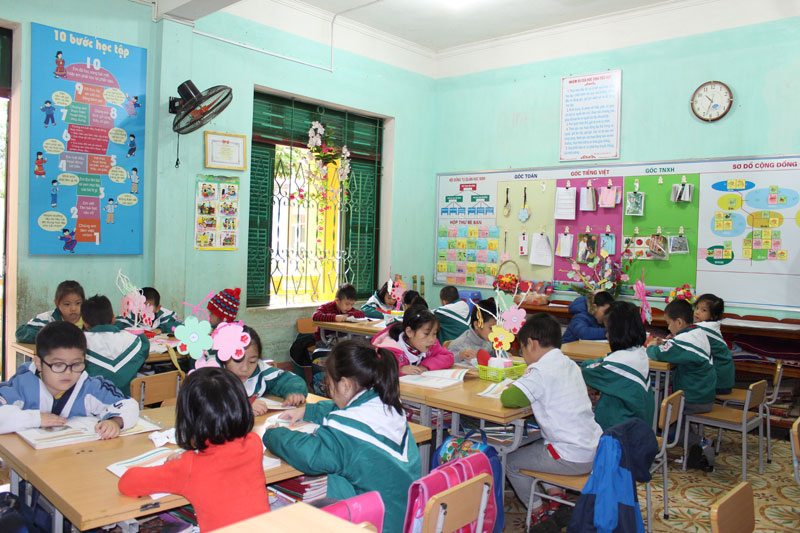
(HBO) – Being a province with 70% population of ethnic minority people, Hoa Binh Department of Education and Training pays special attention to teach Vietnamese and ethnic minority languages.
A Vietnamese lesson of pupils at Mai Chau Town Primary School (Mai Chau).
Mr. Nguyen Duc Luong, The Deputy Director of Education and Training Department confirmed: To continue implementing the Instruction No. 38 on November 29th, 2004 of Prime Minister about strengthening training and fostering ethnic minority languages, the Department has guided all the general education institutions and vocational training centers to organize classes, assessing and giving certificates of ethnic minority languages. In the school year of 2016-2017, The Department of Education and Training organized clases, assessed and gave certificates of Mong and Thai ethnic languages for 213 staffs, officials and teachers in the province area. This helps staffs, officials and teachers become more active and confident in their work at the ethnic minority area.
Especially, on September 8th, 2016, the provincial People’s Committee announced the Decision No. 2295/QD –UBND about approving Muong ethnic letter system in Hoa Binh. This means that the Muong letter system includes 28 letters, 24 first consonants, 1 accompanied sound. To make Muong ethnic language popular in the social life, on October 27th, 2016, the provincial People’s Committee promulgated the Plan No. 118 to exploit the application of Muong ethnic letter system in Hoa Binh province. One of the most typical features of this plan is to design a textbook of learning Muong language which was approved by the authorized office, then organize teaching and learning Muong ethnic language for all people levels in the province. Based on the provincial plans, the Department of Education and Training guided the staffs, officials and teachers in all units and schools to strengthen self-study, foster ethnic minority languages. All the units and schools connect the content of self –studying and fostering the ethnic minority languages closely with fostering regularly for staffs and teachers. All the staffs and teachers have set up plans for self- studying, self- fostering ethnic minority for their teaching and communication with pupils’ parents.
Together with teaching ethnic minority languages, the Department of Education and Training has taken care of teaching Vietnamese for ethnic minority pupils. It has continuously strengthened to implement content of Vietnamese preparation and Vietnamese strengthening for ethnic minority pupils (kindergartens, primary schools) which is relevant to the local situation. On March 10th, 2017, the Department of Education and Training issued the Documentary No. 573 about "Strengthening Vietnamese for ethnic minority children at kindergartens”. For Grade 1 of Ethnic Minority, strengthen Vietnamese in the direction of Ministry of Education and Training”.
The Department has well implemented teaching Vietnamese for ethnic minority pupils in the direction of increasing the amount of learning Vietnamese time by learning 2 lessons/ day or have an extra lesson/ week. 100% schools have organized Vietnamese preparation course for children before Grade 1 (in the summer fostering course). Besides, schools held extra 1-2 Vietnamese classes for children every week, which contributes to improve the general education quality and national education quality.
Especially, the provincial Department has directed all the schools, especially the schools of Hang Kia commune, Pa Co commune of Mai Chau district (with 100% population of Mong people) strengthen the time of teaching Vietnamese for ethnic minority children in the integrating way into school subjects, extra outdoor activities. Schools and teachers usually collaborate with communities and parents to create communicating environment of Vietnamese for ethnic pupils. It really increases the education quality, and cultural knowledge in ethnic minority area.
The emulation movement "Hoa Binh joining hands to build new-style rural areas” has been widely spreading, becoming a driving force that motivates the localities to renew rural landscapes and improve the material and spiritual lives of the residents. In this movement, the people play a central role-both as the main implementers and direct beneficiaries of its outcomes.
In response to the global digital revolution, Hoa Binh Newspaper is transforming itself into a modern and multi-platform media hub, blending cutting-edge technology with a restructured newsroom and a new generation of tech-savvy journalists.
Hoa Binh province’s Association of the Elderly recently held a conference to review the project on expanding the inter-generation self-help club model until 2025.
In a move to implement Resolution No. 57-NQ/TW, issued on December 22, 2024 by the Politburo, which targets breakthroughs in science-technology development, innovation, and digital transformation, the Hoa Binh provincial Department of Health has issued a plan to roll out the "Digital Literacy for All” campaign within the local health sector.
An Nghia Commune (Lạc Sơn District) is one of the communes that achieved the tha standard of the national new rural area in 2018. Entering a new development phase, the commune is now trying to meet the criteria for the advanced new rural development. With the strong political will and the public consensus, the commune is gradually overcoming the challenges to reach this goal, aiming for the sustainable development.



